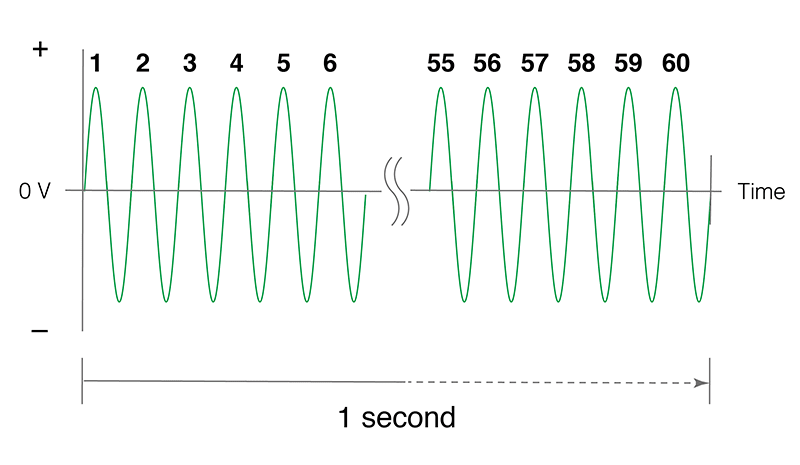What is Frequency?
What does frequency mean for electricity? Introduction to frequency basics, regional factors, and measurement methods
Overview
Since phenomena like electricity and characteristics like voltage are invisible, many people find them difficult and frustrating. However, although it’s true that they can't be seen, in fact they're not all that difficult to understand. This page provides an easy-to-understand introduction to the basics of frequency in the context of electricity and voltage, regional differences in frequency, methods for measuring frequency, and related topics.
Frequency means the number of waves per second.
Frequency refers to the number of times the alternating current (AC) switches between positive and negative in 1 second. This switching does not occur in direct currents (DC). The unit of frequency is hertz (Hz). For example, if a current changes between positive and negative 60 times a second, we say that it has a frequency of 60 Hz.
The amount time it takes the voltage of an AC current to start at 0 (zero), vary from positive to negative, and then return to 0 (zero) (i.e., the amount of time required to complete one cycle) is known as the period, and the frequency is the inverse of the period. High frequency means more waves per second and a shorter period, while low frequency means fewer waves per second and a longer period.
Frequency varies by country
Frequency varies by region: 60 Hz in the U.S., 50 Hz in the UK and Germany, and 60 Hz in South Korea. In most cases, each country uses a single frequency.
An exception to this rule is Japan, where the eastern and western halves of the country uses separate frequencies (50 Hz in the east and 60 Hz in the west). It's extremely unusual for a single country to use multiple frequencies.
In the past, machines used in Japan were limited by frequency
When moving between regions with different frequencies in Japan, for example from eastern Japan to western Japan, you have to check whether you’ll be able to use your current household appliances in your new home. In some cases, you may have to purchase all new appliances when you move.
However, in recent years, a growing number of products are able to accommodate both 50 Hz and 60 Hz frequencies. With more and more products incorporating inverters, which can adjust a motor’s frequency as needed, there’s less risk that using a product in a region with a different frequency will cause degraded performance or malfunctions.
Methods for measuring frequency
Instruments such as digital multimeters with frequency measurement functionality (frequency counters) can be used to measure frequency. Such functionality may be available even on products other than high-end digital multimeters.
These devices are extremely simple to use. Switch the digital multimeter, which generally will provide multiple functions, to frequency measurement (Hz). Then insert the red and black probes into the multimeter’s positive and negative terminals and place the measurement leads in contact with both terminals of the circuit you wish to measure. The frequency in the part of the circuit being measured will be displayed on the LCD.

When making a measurement, don’t forget to switch the instrument to the frequency measurement function before placing the leads in contact with the circuit you wish to measure. Switching functions while the leads are in contact with a circuit could damage the digital multimeter.
Summary
Frequency indicates the number of waves occurring in electricity in 1 second. Worldwide, each country has a defined frequency that it uses, for example 50 Hz or 60 Hz. Japan is a rare exception because the frequency of its power is either 50 Hz or 60 Hz depending on the region. Recently, a growing number of products, including some with inverters, can accommodate both frequencies.
In addition to the power frequency measurement application described above, there are many situations in which frequency is measured.
If you ever need to measure frequency yourself, try using a digital multimeter’s frequency measurement function.
How to Use
- How to use digital multimeters (DMMs) properly and how to choose a safe multimeter
- Using and function of digital multimeters












